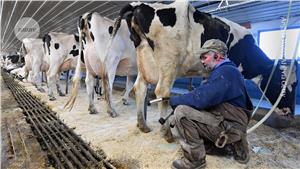In 2024, Space Coast gears up for most astronaut launches since '09
by Richard Tribou, Orlando Sentinel ![]() Credit: CC0 Public Domain The business of sending humans into space has not yet risen to the levels seen during the space shuttle program, but 2024 could see the most U.S.-based orbital launches in 15 years. There are seven missions slated from either Kennedy Space Center or Cape Canaveral Space Force Station that look to place 26 humans into orbit. It's the highest number of crew launching from the Space Coast since 2009. That year saw five shuttle launches with 35 humans on board. The seven planned launches would also be the most since the eight space shuttle launches in 1997. The shuttle era finished with only three launches in 2010 and 2011 before its retirement, and U.S.-based launches did not happen again until the successful May 2020 liftoff of SpaceX's Demo-2 mission flying the Crew Dragon Endeavour to the International Space Station with humans on board for the first time. Since then, SpaceX has been the only orbital U.S.-based launcher of humans in the game, mixing up a combination of missions under NASA's Commercial Crew Program to the ISS as well as private missions to both the station and standalone orbital flights. "This is a pretty exciting time in space," said SpaceX's William Gerstenmaier, formerly NASA's chief of human spaceflight. "There's a lot of commercial interest in spaceflight activities, and I think we feel really lucky on the SpaceX side to be able to support this activity moving forward." But 2024 could see three more crewed vehicles flying from the Space Coast on SpaceX commercial crew and private flights. Al,so the first crewed flight of NASA's Artemis program and its Orion spacecraft and the long-delayed first crewed test flight of Boeing's CST-100 Starliner could happen. Outside of Florida, Russia and China will continue to fly up their crews to orbit while private suborbital flights could continue from Virgin Galactic and Blue Origin. 5 SpaceX flights set SpaceX, which has since 2020 flown up 40 people across 11 flights of four Crew Dragon spacecraft, is teeing up a record five missions in 2024. Launches will come from either KSC's Launch Pad 39-A or Canaveral's Space Launch Complex 40, where SpaceX recently added a crew access arm to allow for double the crew capability on the Space Coast. First up is the Axiom Space 3 mission for a short visit to the ISS as early as January, followed by the Crew-8 mission to send up four replacement crew for a six-month stay on the ISS as early as mid-February. Also still on tap for "no earlier than early 2024," according to the mission website, is the private orbital Polaris Dawn mission taking billionaire Jared Issacman on what would be his second trip to space following the Inspiration4 mission in 2021. Issacman and three others, including two SpaceX employees, plan to go on a five-day flight that features traveling beyond the record of 853 miles altitude set for a human low-Earth orbit mission back in 1966. NASA astronauts Pete Conrad and Richard Gordon flew that high on Gemini 11. It also will feature the first commercial spacewalk as the Crew Dragon Resilience will have all the air sucked out and two of the four crew will venture out into open space on a tether. "There are only about 600 lucky people who have been to orbit. Almost entirely come from world superpowers. And there's a lot of learning that needs to take place as space opens up beyond just the few and into the many," Issacman said at the SpaceCom commercial space convention in Orlando earlier this year. "So, spacewalk. Yay. If we're going to go to moon and make life multiplanetary, we're going to have to leave the safety and comfort of the habitat or the vehicle to do this." SpaceX ends up the year with another ISS crew replacement mission, Crew-9, in mid-August followed by the private Axiom 4 mission to the ISS as early as October. The Axiom missions have ventured beyond the millionaire space tourist demographic as well, now serving the interests of governments looking for access to space for their burgeoning astronaut programs. Axiom 3, for instance, will take up Turkish, Italian and Swedish astronauts, and Axiom, which already has brokered flights for Saudi Arabia and United Arab Emirates to the ISS has agreements with several nations to provide spaceflight opportunities as well. That's something NASA is enthusiastic about. "Our job is to expand what we do in low-Earth orbit across the globe, and anything we can do to accelerate that expansion I think is worthwhile and it's a big goal for us," said NASA International Space Station manager Joel Montalbano. Starliner, Orion teed up One new ISS-bound spacecraft looking to make its human spaceflight debut is Boeing's Starliner. SpaceX won the Commercial Crew Program contract alongside Boeing back in 2014, but Starliner has suffered a series of setbacks that delayed the Crew Flight Test mission, now to no earlier than April. That flight will have just two passengers with NASA astronauts Sunita Williams and Butch Wilmore launching atop a United Launch Alliance Atlas V rocket from Canaveral's Space Launch Complex 41. "For the last honestly eight years I've been working to formulate with [Boeing] the engineering process, how we're going to fly it … how the next crews after us are actually going to use it for return to low-Earth orbit and back to the International Space Station," Williams said in May before a July launch was delayed again. "I'm getting ready to fly this mission finally … This is a brand new spacecraft and so we have to make sure everything's all squared away." Another new spacecraft aiming for its first flight with humans is the Orion capsule set to launch on NASA's Artemis II mission. After the uncrewed success of Artemis I in November 2022, the next step in NASA's moon-to-Mars program is once again targeting liftoff from KSC's Launch Pad 39-B on the powerful Space Launch System rocket. It could fly as early as November 2024, taking NASA astronauts Reid Wiseman, Victor Glover and Christina Koch with Canadian Space Agency astronaut Jeremy Hansen on an eight-day trip around the moon and back on what would be Orion's first human spaceflight following the successful uncrewed Artemis I flight in 2021. "We get asked often what the measure of success for Artemis II is," said Wiseman during an August press conference at KSC after the quartet got to see their ride for the first time. "To the four of us sitting here, the measure of success for Artemis II is seeing our colleagues on the lunar surface, seeing our colleagues assembling [the lunar space station] Gateway, and then seeing people that are following in our footsteps walking on Mars and coming back to planet Earth." Artemis III won't be until at least December 2025, and that could be delayed as well, but that flight's goal is to return humans to the lunar surface for the first time since the end of the Apollo program more than 50 years ago. And NASA's target is still to send humans to Mars before 2040. If Artemis II flies in 2024, it will be the first human mission beyond low-Earth orbit since Apollo 17 in December 1972. The other six slated human spaceflights from the Space Coast in 2024 will stay close to Earth. If all seven flights are successful, they will have sent another 26 people to space. Florida record set in '85 The record for human spaceflight from Florida came in 1985 when the space shuttles launched nine times flying up 58 people. The program sent up eight shuttles in both 1992 and 1997, with both years putting 53 people in space. Of the potential 26 in 2024, only 14 will be from NASA and its traditional space partners from Japan, Canada, the European Space Agency, and Russia. The other 12 will be flying through commercial endeavors. "This is neat to see this beginning…to see how this moves forward," Gerstenmaier said. "This is a very interesting time in human spaceflight, where it's not just a government-only kind of activity. It can actually be accommodated by other governments … and we're really starting to see the beginnings of the commercial space industry start to open up for humans in space." ©2023 Orlando Sentinel.Distributed by Tribune Content Agency, LLC.
Credit: CC0 Public Domain The business of sending humans into space has not yet risen to the levels seen during the space shuttle program, but 2024 could see the most U.S.-based orbital launches in 15 years. There are seven missions slated from either Kennedy Space Center or Cape Canaveral Space Force Station that look to place 26 humans into orbit. It's the highest number of crew launching from the Space Coast since 2009. That year saw five shuttle launches with 35 humans on board. The seven planned launches would also be the most since the eight space shuttle launches in 1997. The shuttle era finished with only three launches in 2010 and 2011 before its retirement, and U.S.-based launches did not happen again until the successful May 2020 liftoff of SpaceX's Demo-2 mission flying the Crew Dragon Endeavour to the International Space Station with humans on board for the first time. Since then, SpaceX has been the only orbital U.S.-based launcher of humans in the game, mixing up a combination of missions under NASA's Commercial Crew Program to the ISS as well as private missions to both the station and standalone orbital flights. "This is a pretty exciting time in space," said SpaceX's William Gerstenmaier, formerly NASA's chief of human spaceflight. "There's a lot of commercial interest in spaceflight activities, and I think we feel really lucky on the SpaceX side to be able to support this activity moving forward." But 2024 could see three more crewed vehicles flying from the Space Coast on SpaceX commercial crew and private flights. Al,so the first crewed flight of NASA's Artemis program and its Orion spacecraft and the long-delayed first crewed test flight of Boeing's CST-100 Starliner could happen. Outside of Florida, Russia and China will continue to fly up their crews to orbit while private suborbital flights could continue from Virgin Galactic and Blue Origin. 5 SpaceX flights set SpaceX, which has since 2020 flown up 40 people across 11 flights of four Crew Dragon spacecraft, is teeing up a record five missions in 2024. Launches will come from either KSC's Launch Pad 39-A or Canaveral's Space Launch Complex 40, where SpaceX recently added a crew access arm to allow for double the crew capability on the Space Coast. First up is the Axiom Space 3 mission for a short visit to the ISS as early as January, followed by the Crew-8 mission to send up four replacement crew for a six-month stay on the ISS as early as mid-February. Also still on tap for "no earlier than early 2024," according to the mission website, is the private orbital Polaris Dawn mission taking billionaire Jared Issacman on what would be his second trip to space following the Inspiration4 mission in 2021. Issacman and three others, including two SpaceX employees, plan to go on a five-day flight that features traveling beyond the record of 853 miles altitude set for a human low-Earth orbit mission back in 1966. NASA astronauts Pete Conrad and Richard Gordon flew that high on Gemini 11. It also will feature the first commercial spacewalk as the Crew Dragon Resilience will have all the air sucked out and two of the four crew will venture out into open space on a tether. "There are only about 600 lucky people who have been to orbit. Almost entirely come from world superpowers. And there's a lot of learning that needs to take place as space opens up beyond just the few and into the many," Issacman said at the SpaceCom commercial space convention in Orlando earlier this year. "So, spacewalk. Yay. If we're going to go to moon and make life multiplanetary, we're going to have to leave the safety and comfort of the habitat or the vehicle to do this." SpaceX ends up the year with another ISS crew replacement mission, Crew-9, in mid-August followed by the private Axiom 4 mission to the ISS as early as October. The Axiom missions have ventured beyond the millionaire space tourist demographic as well, now serving the interests of governments looking for access to space for their burgeoning astronaut programs. Axiom 3, for instance, will take up Turkish, Italian and Swedish astronauts, and Axiom, which already has brokered flights for Saudi Arabia and United Arab Emirates to the ISS has agreements with several nations to provide spaceflight opportunities as well. That's something NASA is enthusiastic about. "Our job is to expand what we do in low-Earth orbit across the globe, and anything we can do to accelerate that expansion I think is worthwhile and it's a big goal for us," said NASA International Space Station manager Joel Montalbano. Starliner, Orion teed up One new ISS-bound spacecraft looking to make its human spaceflight debut is Boeing's Starliner. SpaceX won the Commercial Crew Program contract alongside Boeing back in 2014, but Starliner has suffered a series of setbacks that delayed the Crew Flight Test mission, now to no earlier than April. That flight will have just two passengers with NASA astronauts Sunita Williams and Butch Wilmore launching atop a United Launch Alliance Atlas V rocket from Canaveral's Space Launch Complex 41. "For the last honestly eight years I've been working to formulate with [Boeing] the engineering process, how we're going to fly it … how the next crews after us are actually going to use it for return to low-Earth orbit and back to the International Space Station," Williams said in May before a July launch was delayed again. "I'm getting ready to fly this mission finally … This is a brand new spacecraft and so we have to make sure everything's all squared away." Another new spacecraft aiming for its first flight with humans is the Orion capsule set to launch on NASA's Artemis II mission. After the uncrewed success of Artemis I in November 2022, the next step in NASA's moon-to-Mars program is once again targeting liftoff from KSC's Launch Pad 39-B on the powerful Space Launch System rocket. It could fly as early as November 2024, taking NASA astronauts Reid Wiseman, Victor Glover and Christina Koch with Canadian Space Agency astronaut Jeremy Hansen on an eight-day trip around the moon and back on what would be Orion's first human spaceflight following the successful uncrewed Artemis I flight in 2021. "We get asked often what the measure of success for Artemis II is," said Wiseman during an August press conference at KSC after the quartet got to see their ride for the first time. "To the four of us sitting here, the measure of success for Artemis II is seeing our colleagues on the lunar surface, seeing our colleagues assembling [the lunar space station] Gateway, and then seeing people that are following in our footsteps walking on Mars and coming back to planet Earth." Artemis III won't be until at least December 2025, and that could be delayed as well, but that flight's goal is to return humans to the lunar surface for the first time since the end of the Apollo program more than 50 years ago. And NASA's target is still to send humans to Mars before 2040. If Artemis II flies in 2024, it will be the first human mission beyond low-Earth orbit since Apollo 17 in December 1972. The other six slated human spaceflights from the Space Coast in 2024 will stay close to Earth. If all seven flights are successful, they will have sent another 26 people to space. Florida record set in '85 The record for human spaceflight from Florida came in 1985 when the space shuttles launched nine times flying up 58 people. The program sent up eight shuttles in both 1992 and 1997, with both years putting 53 people in space. Of the potential 26 in 2024, only 14 will be from NASA and its traditional space partners from Japan, Canada, the European Space Agency, and Russia. The other 12 will be flying through commercial endeavors. "This is neat to see this beginning…to see how this moves forward," Gerstenmaier said. "This is a very interesting time in human spaceflight, where it's not just a government-only kind of activity. It can actually be accommodated by other governments … and we're really starting to see the beginnings of the commercial space industry start to open up for humans in space." ©2023 Orlando Sentinel.Distributed by Tribune Content Agency, LLC.

 Credit: CC0 Public Domain The business of sending humans into space has not yet risen to the levels seen during the space shuttle program, but 2024 could see the most U.S.-based orbital launches in 15 years. There are seven missions slated from either Kennedy Space Center or Cape Canaveral Space Force Station that look to place 26 humans into orbit. It's the highest number of crew launching from the Space Coast since 2009. That year saw five shuttle launches with 35 humans on board. The seven planned launches would also be the most since the eight space shuttle launches in 1997. The shuttle era finished with only three launches in 2010 and 2011 before its retirement, and U.S.-based launches did not happen again until the successful May 2020 liftoff of SpaceX's Demo-2 mission flying the Crew Dragon Endeavour to the International Space Station with humans on board for the first time. Since then, SpaceX has been the only orbital U.S.-based launcher of humans in the game, mixing up a combination of missions under NASA's Commercial Crew Program to the ISS as well as private missions to both the station and standalone orbital flights. "This is a pretty exciting time in space," said SpaceX's William Gerstenmaier, formerly NASA's chief of human spaceflight. "There's a lot of commercial interest in spaceflight activities, and I think we feel really lucky on the SpaceX side to be able to support this activity moving forward." But 2024 could see three more crewed vehicles flying from the Space Coast on SpaceX commercial crew and private flights. Al,so the first crewed flight of NASA's Artemis program and its Orion spacecraft and the long-delayed first crewed test flight of Boeing's CST-100 Starliner could happen. Outside of Florida, Russia and China will continue to fly up their crews to orbit while private suborbital flights could continue from Virgin Galactic and Blue Origin. 5 SpaceX flights set SpaceX, which has since 2020 flown up 40 people across 11 flights of four Crew Dragon spacecraft, is teeing up a record five missions in 2024. Launches will come from either KSC's Launch Pad 39-A or Canaveral's Space Launch Complex 40, where SpaceX recently added a crew access arm to allow for double the crew capability on the Space Coast. First up is the Axiom Space 3 mission for a short visit to the ISS as early as January, followed by the Crew-8 mission to send up four replacement crew for a six-month stay on the ISS as early as mid-February. Also still on tap for "no earlier than early 2024," according to the mission website, is the private orbital Polaris Dawn mission taking billionaire Jared Issacman on what would be his second trip to space following the Inspiration4 mission in 2021. Issacman and three others, including two SpaceX employees, plan to go on a five-day flight that features traveling beyond the record of 853 miles altitude set for a human low-Earth orbit mission back in 1966. NASA astronauts Pete Conrad and Richard Gordon flew that high on Gemini 11. It also will feature the first commercial spacewalk as the Crew Dragon Resilience will have all the air sucked out and two of the four crew will venture out into open space on a tether. "There are only about 600 lucky people who have been to orbit. Almost entirely come from world superpowers. And there's a lot of learning that needs to take place as space opens up beyond just the few and into the many," Issacman said at the SpaceCom commercial space convention in Orlando earlier this year. "So, spacewalk. Yay. If we're going to go to moon and make life multiplanetary, we're going to have to leave the safety and comfort of the habitat or the vehicle to do this." SpaceX ends up the year with another ISS crew replacement mission, Crew-9, in mid-August followed by the private Axiom 4 mission to the ISS as early as October. The Axiom missions have ventured beyond the millionaire space tourist demographic as well, now serving the interests of governments looking for access to space for their burgeoning astronaut programs. Axiom 3, for instance, will take up Turkish, Italian and Swedish astronauts, and Axiom, which already has brokered flights for Saudi Arabia and United Arab Emirates to the ISS has agreements with several nations to provide spaceflight opportunities as well. That's something NASA is enthusiastic about. "Our job is to expand what we do in low-Earth orbit across the globe, and anything we can do to accelerate that expansion I think is worthwhile and it's a big goal for us," said NASA International Space Station manager Joel Montalbano. Starliner, Orion teed up One new ISS-bound spacecraft looking to make its human spaceflight debut is Boeing's Starliner. SpaceX won the Commercial Crew Program contract alongside Boeing back in 2014, but Starliner has suffered a series of setbacks that delayed the Crew Flight Test mission, now to no earlier than April. That flight will have just two passengers with NASA astronauts Sunita Williams and Butch Wilmore launching atop a United Launch Alliance Atlas V rocket from Canaveral's Space Launch Complex 41. "For the last honestly eight years I've been working to formulate with [Boeing] the engineering process, how we're going to fly it … how the next crews after us are actually going to use it for return to low-Earth orbit and back to the International Space Station," Williams said in May before a July launch was delayed again. "I'm getting ready to fly this mission finally … This is a brand new spacecraft and so we have to make sure everything's all squared away." Another new spacecraft aiming for its first flight with humans is the Orion capsule set to launch on NASA's Artemis II mission. After the uncrewed success of Artemis I in November 2022, the next step in NASA's moon-to-Mars program is once again targeting liftoff from KSC's Launch Pad 39-B on the powerful Space Launch System rocket. It could fly as early as November 2024, taking NASA astronauts Reid Wiseman, Victor Glover and Christina Koch with Canadian Space Agency astronaut Jeremy Hansen on an eight-day trip around the moon and back on what would be Orion's first human spaceflight following the successful uncrewed Artemis I flight in 2021. "We get asked often what the measure of success for Artemis II is," said Wiseman during an August press conference at KSC after the quartet got to see their ride for the first time. "To the four of us sitting here, the measure of success for Artemis II is seeing our colleagues on the lunar surface, seeing our colleagues assembling [the lunar space station] Gateway, and then seeing people that are following in our footsteps walking on Mars and coming back to planet Earth." Artemis III won't be until at least December 2025, and that could be delayed as well, but that flight's goal is to return humans to the lunar surface for the first time since the end of the Apollo program more than 50 years ago. And NASA's target is still to send humans to Mars before 2040. If Artemis II flies in 2024, it will be the first human mission beyond low-Earth orbit since Apollo 17 in December 1972. The other six slated human spaceflights from the Space Coast in 2024 will stay close to Earth. If all seven flights are successful, they will have sent another 26 people to space. Florida record set in '85 The record for human spaceflight from Florida came in 1985 when the space shuttles launched nine times flying up 58 people. The program sent up eight shuttles in both 1992 and 1997, with both years putting 53 people in space. Of the potential 26 in 2024, only 14 will be from NASA and its traditional space partners from Japan, Canada, the European Space Agency, and Russia. The other 12 will be flying through commercial endeavors. "This is neat to see this beginning…to see how this moves forward," Gerstenmaier said. "This is a very interesting time in human spaceflight, where it's not just a government-only kind of activity. It can actually be accommodated by other governments … and we're really starting to see the beginnings of the commercial space industry start to open up for humans in space." ©2023 Orlando Sentinel.Distributed by Tribune Content Agency, LLC.
Credit: CC0 Public Domain The business of sending humans into space has not yet risen to the levels seen during the space shuttle program, but 2024 could see the most U.S.-based orbital launches in 15 years. There are seven missions slated from either Kennedy Space Center or Cape Canaveral Space Force Station that look to place 26 humans into orbit. It's the highest number of crew launching from the Space Coast since 2009. That year saw five shuttle launches with 35 humans on board. The seven planned launches would also be the most since the eight space shuttle launches in 1997. The shuttle era finished with only three launches in 2010 and 2011 before its retirement, and U.S.-based launches did not happen again until the successful May 2020 liftoff of SpaceX's Demo-2 mission flying the Crew Dragon Endeavour to the International Space Station with humans on board for the first time. Since then, SpaceX has been the only orbital U.S.-based launcher of humans in the game, mixing up a combination of missions under NASA's Commercial Crew Program to the ISS as well as private missions to both the station and standalone orbital flights. "This is a pretty exciting time in space," said SpaceX's William Gerstenmaier, formerly NASA's chief of human spaceflight. "There's a lot of commercial interest in spaceflight activities, and I think we feel really lucky on the SpaceX side to be able to support this activity moving forward." But 2024 could see three more crewed vehicles flying from the Space Coast on SpaceX commercial crew and private flights. Al,so the first crewed flight of NASA's Artemis program and its Orion spacecraft and the long-delayed first crewed test flight of Boeing's CST-100 Starliner could happen. Outside of Florida, Russia and China will continue to fly up their crews to orbit while private suborbital flights could continue from Virgin Galactic and Blue Origin. 5 SpaceX flights set SpaceX, which has since 2020 flown up 40 people across 11 flights of four Crew Dragon spacecraft, is teeing up a record five missions in 2024. Launches will come from either KSC's Launch Pad 39-A or Canaveral's Space Launch Complex 40, where SpaceX recently added a crew access arm to allow for double the crew capability on the Space Coast. First up is the Axiom Space 3 mission for a short visit to the ISS as early as January, followed by the Crew-8 mission to send up four replacement crew for a six-month stay on the ISS as early as mid-February. Also still on tap for "no earlier than early 2024," according to the mission website, is the private orbital Polaris Dawn mission taking billionaire Jared Issacman on what would be his second trip to space following the Inspiration4 mission in 2021. Issacman and three others, including two SpaceX employees, plan to go on a five-day flight that features traveling beyond the record of 853 miles altitude set for a human low-Earth orbit mission back in 1966. NASA astronauts Pete Conrad and Richard Gordon flew that high on Gemini 11. It also will feature the first commercial spacewalk as the Crew Dragon Resilience will have all the air sucked out and two of the four crew will venture out into open space on a tether. "There are only about 600 lucky people who have been to orbit. Almost entirely come from world superpowers. And there's a lot of learning that needs to take place as space opens up beyond just the few and into the many," Issacman said at the SpaceCom commercial space convention in Orlando earlier this year. "So, spacewalk. Yay. If we're going to go to moon and make life multiplanetary, we're going to have to leave the safety and comfort of the habitat or the vehicle to do this." SpaceX ends up the year with another ISS crew replacement mission, Crew-9, in mid-August followed by the private Axiom 4 mission to the ISS as early as October. The Axiom missions have ventured beyond the millionaire space tourist demographic as well, now serving the interests of governments looking for access to space for their burgeoning astronaut programs. Axiom 3, for instance, will take up Turkish, Italian and Swedish astronauts, and Axiom, which already has brokered flights for Saudi Arabia and United Arab Emirates to the ISS has agreements with several nations to provide spaceflight opportunities as well. That's something NASA is enthusiastic about. "Our job is to expand what we do in low-Earth orbit across the globe, and anything we can do to accelerate that expansion I think is worthwhile and it's a big goal for us," said NASA International Space Station manager Joel Montalbano. Starliner, Orion teed up One new ISS-bound spacecraft looking to make its human spaceflight debut is Boeing's Starliner. SpaceX won the Commercial Crew Program contract alongside Boeing back in 2014, but Starliner has suffered a series of setbacks that delayed the Crew Flight Test mission, now to no earlier than April. That flight will have just two passengers with NASA astronauts Sunita Williams and Butch Wilmore launching atop a United Launch Alliance Atlas V rocket from Canaveral's Space Launch Complex 41. "For the last honestly eight years I've been working to formulate with [Boeing] the engineering process, how we're going to fly it … how the next crews after us are actually going to use it for return to low-Earth orbit and back to the International Space Station," Williams said in May before a July launch was delayed again. "I'm getting ready to fly this mission finally … This is a brand new spacecraft and so we have to make sure everything's all squared away." Another new spacecraft aiming for its first flight with humans is the Orion capsule set to launch on NASA's Artemis II mission. After the uncrewed success of Artemis I in November 2022, the next step in NASA's moon-to-Mars program is once again targeting liftoff from KSC's Launch Pad 39-B on the powerful Space Launch System rocket. It could fly as early as November 2024, taking NASA astronauts Reid Wiseman, Victor Glover and Christina Koch with Canadian Space Agency astronaut Jeremy Hansen on an eight-day trip around the moon and back on what would be Orion's first human spaceflight following the successful uncrewed Artemis I flight in 2021. "We get asked often what the measure of success for Artemis II is," said Wiseman during an August press conference at KSC after the quartet got to see their ride for the first time. "To the four of us sitting here, the measure of success for Artemis II is seeing our colleagues on the lunar surface, seeing our colleagues assembling [the lunar space station] Gateway, and then seeing people that are following in our footsteps walking on Mars and coming back to planet Earth." Artemis III won't be until at least December 2025, and that could be delayed as well, but that flight's goal is to return humans to the lunar surface for the first time since the end of the Apollo program more than 50 years ago. And NASA's target is still to send humans to Mars before 2040. If Artemis II flies in 2024, it will be the first human mission beyond low-Earth orbit since Apollo 17 in December 1972. The other six slated human spaceflights from the Space Coast in 2024 will stay close to Earth. If all seven flights are successful, they will have sent another 26 people to space. Florida record set in '85 The record for human spaceflight from Florida came in 1985 when the space shuttles launched nine times flying up 58 people. The program sent up eight shuttles in both 1992 and 1997, with both years putting 53 people in space. Of the potential 26 in 2024, only 14 will be from NASA and its traditional space partners from Japan, Canada, the European Space Agency, and Russia. The other 12 will be flying through commercial endeavors. "This is neat to see this beginning…to see how this moves forward," Gerstenmaier said. "This is a very interesting time in human spaceflight, where it's not just a government-only kind of activity. It can actually be accommodated by other governments … and we're really starting to see the beginnings of the commercial space industry start to open up for humans in space." ©2023 Orlando Sentinel.Distributed by Tribune Content Agency, LLC.







